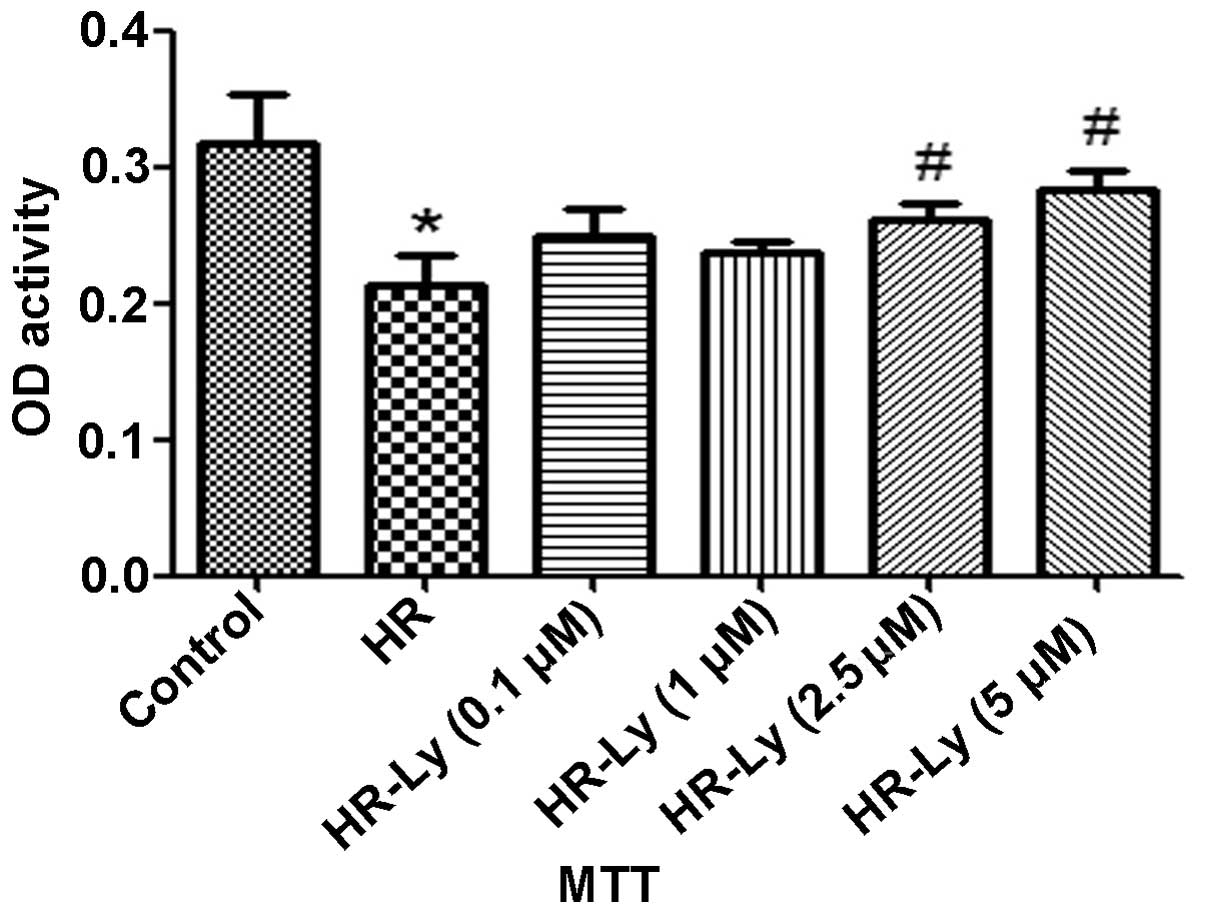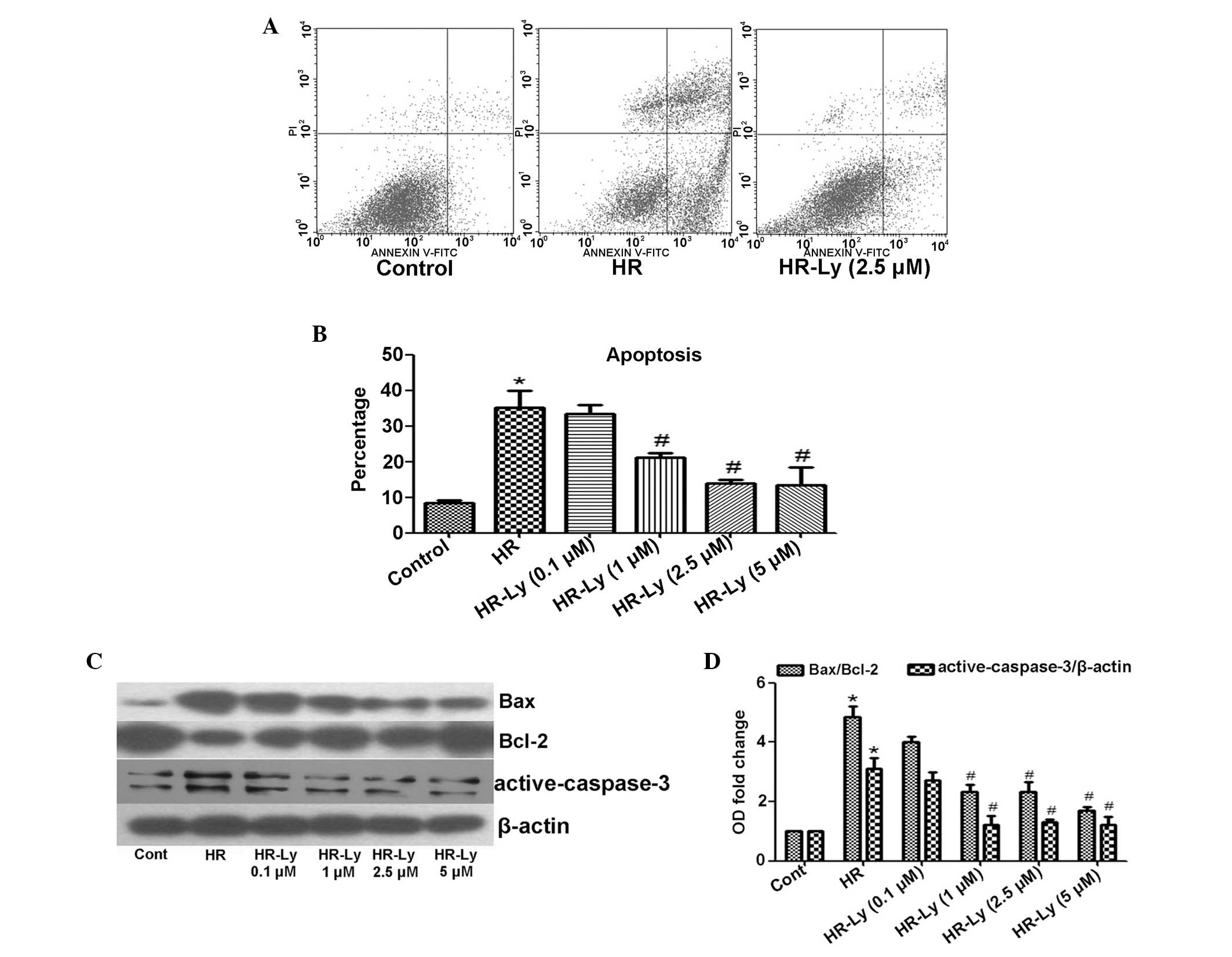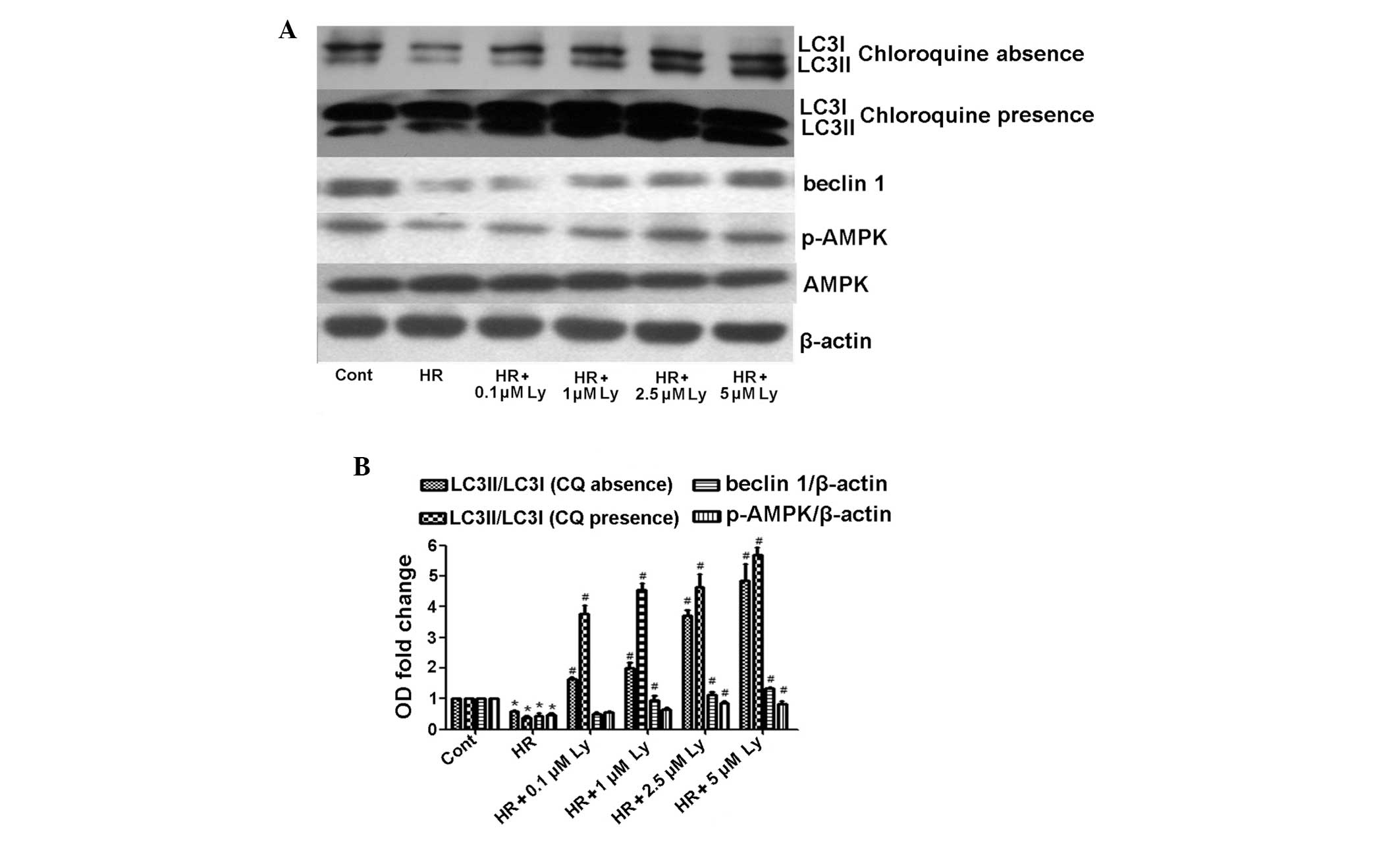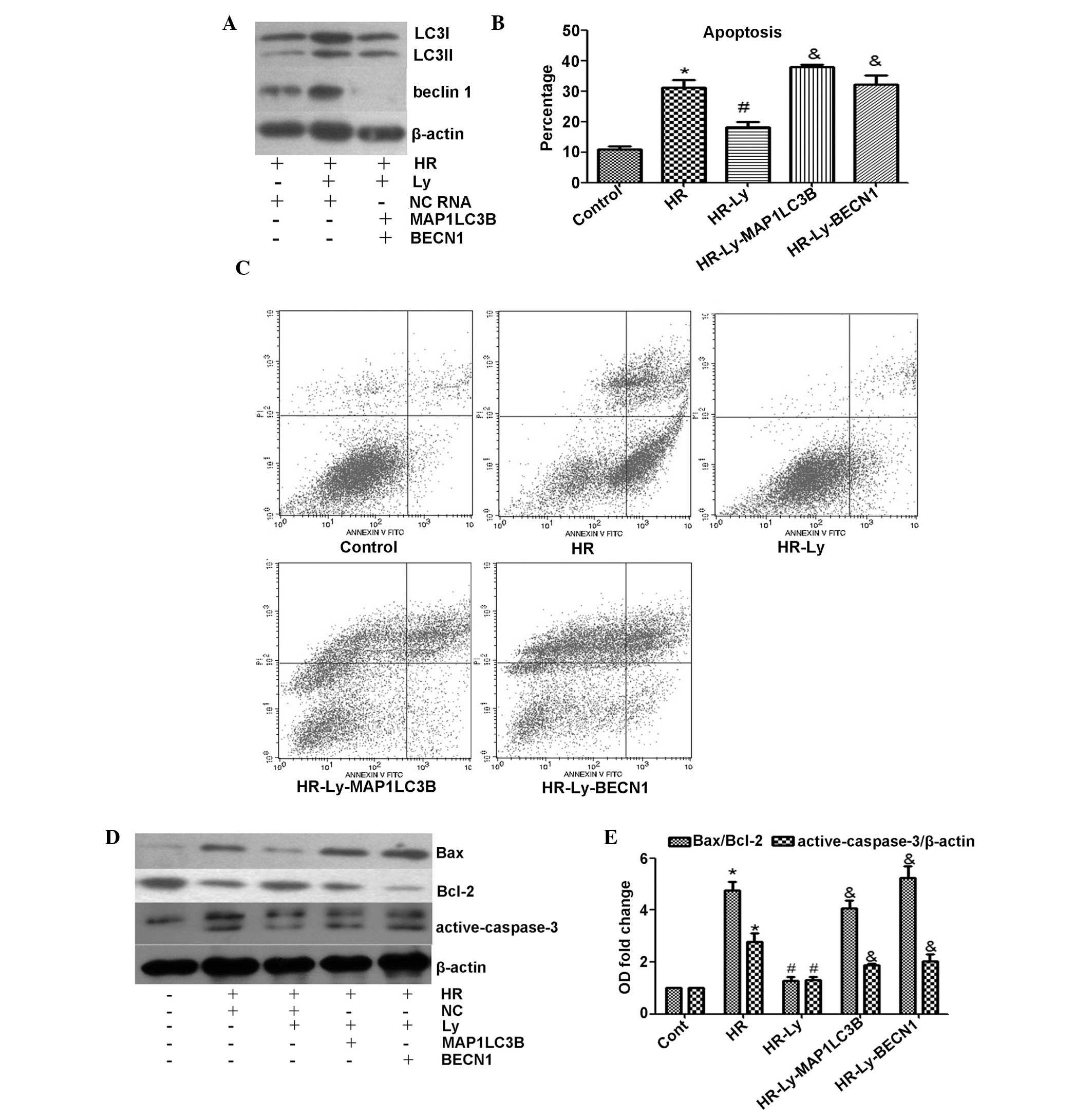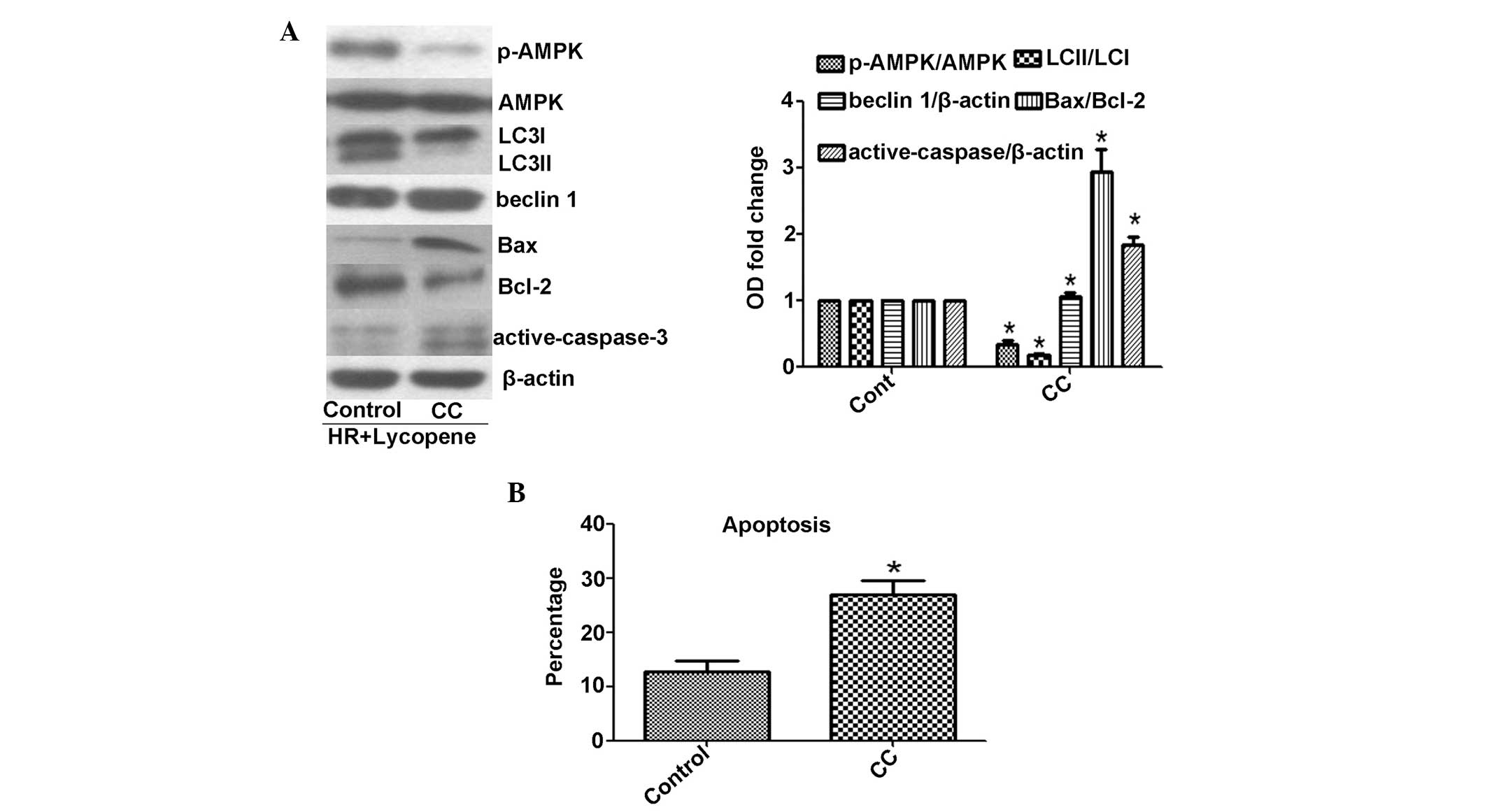Lycopene protects against apoptosis in hypoxia/reoxygenation‑induced H9C2 myocardioblast cells through increased autophagy
- Authors:
- Published online on: October 27, 2014 https://doi.org/10.3892/mmr.2014.2771
- Pages: 1358-1365
Abstract
Introduction
Ischemic heart disease is the primary cause of fatalities in developed countries, contributing to ~40% of total mortality (1). One type of ischemic heart disease condition, ischemia/reperfusion (IR) injury, induces myocardiocyte apoptosis and necrosis, and contributes to 25% of the total mortality in patients with acute myocardial infarction (2). In addition, IR injury results in the degradation of excess autophagic flux, and the recycling of misfolded proteins or dysfunctional organelles (3). With a ‘housekeeper’ function, autophagy is critical in maintaining cellular homeostasis and mediating resistance to apoptosis or senescence (4). Although the protective role of autophagy is widely known, the adaptive autophagic mechanism during myocardiocyte survival remains controversial (5). For example, the induction of autophagy through autophagy-related gene 7 (Atg7) overexpression was shown to be protective in the heart during ischemia (6). However, activated autophagy has been associated with aggravated cardiac hypertrophy in pressure overload-induced heart failure (7). Recently, adenosine and acetylcholine have been shown to provide cardioprotective effects through an underlying autophagy-dependent mechanism (8,9). Thus, autophagy may be required for myocardiocyte survival during ischemia.
Lycopene (Ly), the most common type of carotenoid in dietary intake, has been shown to confer protective effects against ageing, tissue damage, certain types of cancer, atherosclerosis and associated coronary artery disease (10). Possible mechanisms of Ly-mediated effects are via antioxidant activity, increases in gap-junctional intercellular communication, cell growth control, the activation of the mevalonic acid pathway, suppressing the expression of the oncogene ras and the modulation of immune responses (11–14). However, the impact of Ly on IR injury induced by myocardiocyte apoptosis and necrosis has been poorly investigated. During IR, the balance between reactive oxygen species (ROS) generation and elimination is critical in determining cell survival (15). Furthermore, the deregulation of ROS directly induces autophagy in various stress conditions (16). Therefore, Ly may induce autophagy to switch from the cell death pathway to survival in hypoxia/reoxygenation (HR)-induced H9C2 myocardioblast cells.
The present study was conducted to investigate whether the autophagy induced by Ly is associated with HR-induced H9C2 myocardioblast cell damage and whether the proautophagic effect of Ly is involved in the cell protection mechanism.
Materials and methods
Reagents
Dulbecco’s modified Eagle’s medium (DMEM), fetal bovine serum (FBS) and Lipofectamine RNAiMax were purchased from Invitrogen (Carlsbad, CA, USA). Microtubule-associated protein 1-light chain 3β (MAP1LC3B), BECN1 and negative control (NC) small interfering (si)RNA were synthesized by GenePharma (Shanghai, China). The chemical reagents compound C (CC), Ly, chloroquine and 3-(4,5-dimethylthiazol-2-yl)-2,5-diphenyl-tetrazolium bromide (MTT), were obtained from Sigma-Aldrich (St. Louis, MO, USA). The cell apoptosis detection kit was purchased from BD Biosciences (Franklin Lakes, NJ, USA). Rabbit monoclonal antibodies specific to LC3 (2057-1; 1:5000), phospho-adenosine monophosphate kinase (p-AMPK, 2802-1, 1:1000), AMPK (1596-1, 1:10000), Bax (1063-1, 1:5000), B-cell lymphoma 2 (Bcl-2, 1017-1, 1:1000 ) and β-actin (5779-1, 1:10000) and the horseradish peroxidase (HRP) conjugated goat anti-rabbit immunoglobulin (Ig) G secondary antibody (3053-1, 1:10000) were obtained from Epitomics (Burlingame, CA, USA). Rabbit monoclonal antibodies specific to Beclin 1 (3738, 1:1000) and active-caspase-3 (9660, 1:1000) were purchased from Cell Signaling Technology (Denver, MA, USA).. The H9C2 cell line was donated by the Pharmacological Laboratory of Zhejiang University (Hangzhou, China).
Cell culture
The H9C2 cells were grown to 80% confluence in DMEM containing 10% FBS at 37°C in a humidified 5% CO2/95% air atmosphere. Subsequent to starvation in serum-free DMEM for 6 h in a normal atmosphere, the H9C2 cells were immediately incubated in serum- and glucose-free DMEM and were moved into a hypoxic atmosphere containing 94% N2, 5% CO2 and 1% O2 to mimic ischemia.. After 16 h of hypoxia, the cells were rapidly transferred into a normal atmosphere with DMEM containing 10% FBS and glucose for reoxygenation (2 h). Prior to the HR, the H9C2 cells were treated with MAP1LC3B, BECN1 or NC siRNA, or Ly, with or without chloroquine, for 48 h, and 1 μM CC was added for 24 h prior to HR to suppress AMPK phosphorylation.
siRNA transfection
The following siRNA sequences were transfected into the cells: MAP1LC3B sense, 5′-CUCCCUAAGAGGAUCUUUATT-3′; MAP1LC3B antisense, 5′-UAAAGAUCCUCUUAGGGAGTT-3′; BECN1 sense, 5′-GUGGAAUGGAAUGAGAUUATT-3′; BECN1 antisense, 5′-UAAUCUCAUUCCAUUCCACTT-3′; NC sense, 5′-UUCUCCGAACGUGUCACGUTT-3′; and NC antisense, 5′-ACGUGACACGUUCGGAGAATT-3′. The H9C2 cells were transfected with the respective siRNAs according to the instructions provided by the manufacturers of Lipofectamine RNAiMax.
Cell viability assay
The H9C2 cells were seeded in 96-well plates. Following HR, 5 mg/ml MTT solution was added and the cells were incubated for 4 h at 37°C. The supernatants were then removed and the cells were solubilized with 150 μl dimethyl sulfoxide (Shanghai Shengong Biotechnology Co., Shanghai, China). The absorbance at 490 nm was measured using an ELISA plate reader (Model 550; Bio-Rad, Hercules, CA, USA).
Detection of cell apoptosis
Following HR treatment, the cells were harvested and incubated with 5 μl Annexin V-fluorescein isothiocyanate and 2.5 μg/ml propidium iodide (PI) for 15 min, and then subjected to flow cytometric analysis (BD FACS; BD Biosciences, Franklin, NJ, USA).
Western blotting
Subsequent to HR, followed by careful washing, the H9C2 cells were harvested and lysed on ice for 45 min using moderate lysis buffer (Beyotime, Haimen, China). Equal quantities of cell proteins were separated via sodium dodecyl sulfate-polyacrylamide gel electrophoresis and were then transferred to polyvinylidene fluoride membranes (Millipore, Billerica, MA, USA). The membranes were blocked with 5% non-fat dry milk for 1 h at room temperature and then probed with primary antibodies overnight at 4°C, then washed with 1× TBST (Shanghai Shengong Biotechnology Co., Shanghai, China) for 3×10 min. Following expose to the horse radish peroxidase-conjugated secondary antibodies for 1 h at room temperature and then washed with 1× TBST for 3×10 min, immunoreactivity was detected using an enhanced chemiluminescence reagent (Bio-Max, Haemek, Israel).
Statistical analysis
The data are presented as the means ± standard error of the mean from a minimum of three experiments and analyzed with a one-way analysis of variance using SPSS 14.0 for Windows (SPSS, Inc., Chicago, IL, USA). P<0.05 was considered to indicate a statistically significant difference.
Results
Ly improves HR-induced H9C2 cell viability
The MTT assay revealed that H9C2 cell viability was significantly reduced following 16/2 h H/R. Pre-incubation of the H9C2 cells with Ly resulted in the development of tolerance to HR in a dose-dependent manner (Fig. 1). These data indicate that Ly protected the H9C2 cells against HR-induced damage.
Ly reduces HR-induced H9C2 cell apoptosis
HR in H9C2 cells has been shown to result in an increase in the rate of apoptosis (9); therefore, whether Ly reduces the rate of H9C2 cell apoptosis following HR administration was investigated in the present study. As expected, HR treatment for 16/2 h significantly increased the percentage of apoptotic cells (Annexin V-positive, PI-positive and -negative cells) to 35.05%, as compared with that of the untreated cells (8.48%; P<0.05). Preincubation of HR-treated cells in Ly-enriched cell-medium significantly reduced the percentage of apoptotic cells to 21.22 (Ly, 1 μM), 13.9 (Ly, 2.5 μM) and 13.51% (Ly, 5 μM; all P<0.05; Fig. 2A and B), as compared with HR-treated cells maintained in control medium. To further examine the association between the inhibition of apoptosis and Ly treatment, the expression levels of the Bax/Bcl-2 and active-caspase-3 proteins, commonly used as apoptotic biomarkers, were detected. The data reveal significantly elevated levels of Bax/Bcl-2 (3.85-fold) and active-caspase-3 (2.12-fold) in the HR-treated cells (P<0.05); however, the Bax/Bcl-2 and active-caspase-3 protein expression levels in the HR-treated cells were reduced following the addition of Ly (Fig. 2C and D). These data indicate that Ly protected the H9C2 cells against HR-induced apoptosis.
Ly increases autophagy in HR-induced H9C2 cells
As autophagy mediates resistance to apoptosis in stress conditions (4), the effect of Ly on autophagy during HR was investigated. Immunoblotting images revealed significantly lower levels of LC3II/LC3I (0.58-fold) and Beclin 1 (0.44-fold) in HR cells, as compared with control cells (P<0.05); however, the levels of these biomarkers in HR-induced cells were elevated by the addition of Ly in a concentration-dependent manner (Fig. 3A and B). An increase in LC3II/LC3I has been previously shown to reflect the impaired fusion of autophagosomes with lysosomes (4). In the present study, to accurately evaluate autophagic flux, chloroquine was used to inhibit autophagolysosomal degradation. Administration of chloroquine prior to HR treatment caused a further reduction in the LC3II/LC3I ratio, a 0.39-fold reduction from the control cell value, as compared with 0.58-fold reduction in HR-induced cells without chloroquine treatment (Fig. 3A and B). However, the addition of Ly with chloroquine increased the LC3II/LC3I ratio in HR-induced cells. These data indicate that Ly induces autophagic flux upregulation in HR-induced H9C2 cells.
MAP1LC3B or BECN1 knockdown enhances apoptosis in HR-induced H9C2 cells
Autophagy biogenesis is initiated by the activation of the Unc-51-like kinase 1 (ULK1) complex and the recruitment of the Beclin 1 complex, and the “isolation membrane” elongates under the LC3-phosphatidylethanolamine (PE) complex (17). To investigate the potential protective effect of autophagy on HR-induced H9C2 cells, MCP1LC3B or BECN1 siRNA was used to inhibit autophagic flux. As expected, MCP1LC3B and BECN1 siRNA effectively inhibited LC3 and Beclin 1 protein expression, respectively (Fig. 4A). Following incubation with MCP1LC3B or BECN1 siRNA, the H9C2 cells were subjected to HR. When autophagy was activated with the addition of Ly, the percentage of apoptotic cells was significantly reduced, as compared with the HR treatment only cells (P<0.05; Fig. 4B and C). When autophagy was inhibited with MCP1LC3B or BECN1 siRNA, the protective effect of Ly against apoptosis disappeared. To further analyze the cytoprotective effect of autophagy, Bax and active-caspase-3 protein expression levels were examined. Notably, autophagic deficiency abolished Ly treatment-mediated inhibition of Bax/Bcl-2 expression and also significantly increased the levels of active-caspase-3 during HR, as compared with those in cells treated with Ly only (Fig. 4D and E). These data indicate that autophagy protects H9C2 cells against apoptosis during HR following Ly administration.
Suppression of AMPK phosphorylation induces autophagic inhibition and cell apoptosis
AMPK is known to activate autophagy in a ULK1-dependent manner. AMPK phosphorylation initiates site specific phosphorylation of ULK1 and subsequently induces formation of the ULK1-complex (17). The data from the present study indicated significantly reduced AMPK phosphorylation in HR-treated H9C2 cells, as compared with control cells (P<0.05), although the levels of AMPK phosphorylation in the HR cells were higher following Ly administration (Fig. 3). To determine whether AMPK phosphorylation is responsible for Ly-induced autophagy, AMPK phosphorylation was suppressed using CC. The CC treatment significantly reduced AMPK phosphorylation (P<0.05; Fig. 5A). In addition, as compared with control HR and Ly-treatment, the addition of CC significantly reduced the LC3II/LC3I ratio (P<0.05), induced significantly higher Bax/Bcl-2 and activate-caspase-3 expression levels (P<0.05) and significantly increased the apoptotic cell percentage (P<0.05) upon HR and Ly administration (Fig. 5A and B). The ULK1-complex and Beclin 1-complex exhibit different regulation mechanisms, as AMPK phosphorylation has been demonstrated to not affect Beclin 1 expression (17). In the present study, the Beclin 1 expression levels were not altered upon CC stress (Fig. 5A). These results indicate that AMPK phosphorylation-mediated autophagy exerted cytoprotective effects in HR-induced H9C2 cells following Ly treatment.
Discussion
In the present study, HR treatment was demonstrated to suppress autophagic flux and increase the rate of apoptosis in H9C2 cells. Nevertheless, preincubation with Ly ameliorated HR-induced H9C2 cell autophagic inhibition and, in turn, reduced cell apoptosis. The role of autophagic regulation in HR-induced H9C2 cell damage following Ly administration was further verified by MCP1LC3B or BECN1 knockdown. In addition, the prevention of AMPK phosphorylation using CC reduced Ly-induced autophagy and increased H9C2 cell apoptosis upon HR stress. Therefore, autophagy exerted a protective effect on HR-induced H9C2 cells following Ly administration and AMPK phosphorylation may be involved in the regulation of this Ly-induced autophagy.
In response to stimuli, the ULK1 complex and the Beclin 1 complex produce phosphatidylinositol 3-phosphate, and a number of Atg proteins are recruited to initiate autophagy. Subsequently, Atg4 induces LC3 cleavage to LC3I, which becomes conjugated to PE to form LC3II, a protein critical for the elongation and closure of the phagophore. LC3II is then incorporated into the autophagosomal membranes. When the autophagosome fuses with lysosome and degenerates, LC3II reverts to LC3I, is released from the autophagolysosome and is available for future autophagosome formation (17,18). ULK1 site-specific phosphorylation is crucial for the assembly of the ULK1 complex and nucleation of the phagophore. AMPK is required for ULK1 phosphorylation and induction of autophagy. Knockdown of AMPK results in ULK1 dephosphorylation and autophagy impairment (16). As a required quality control mechanism, autophagy promotes cell homeostasis during stress conditions; however, inappropriate autophagy accelerates cell death (19). Therefore, whether autophagy exerts a protective effect in cardiovascular diseases remains controversial. Basal autophagy allows cells to constitutively clear damaged organelles and misfolded proteins. Upon exposure to stressors, such as IR injury and heart failure, rapidly upregulated autophagy is an adaptive response to prevent excessive ROS production, the consumption of ATP, the release of pro-apoptotic factors, the opening of mitochondrial permeability transition pores, and the induction of necrosis or apoptosis (20). Reduced survival and increased cardiac dysfunction have been observed in mice with hearts deficient in Parkin, a required factor for mitophagy, following myocardial infarction (21). In addition, the losses of Atg5 (22), a crucial autophagic initiation factor, and myeloid cell leukemia 1 (23), an analogue of Bcl-2, in adult heart have been shown to result in deficient autophagy and rapid heart failure. In clinical patients, lysosome-associated membrane protein 2 deficiency, a critical fusion factor between autophagosomes and lysosomes, results in a lethal cardiac hypertrophy (24). By contrast, autophagy-mediated maladaptive effects on cardiac diseases have been reported. During pressure overload, angiotensin II-mediated autophagy induces cardiac contractile dysfunction, pathologic remodeling and cardiac atrophy (25), and during the IR-injury phase, accumulating evidence has indicated that the induction of autophagy is harmful for cardiomyocyte survival, particularly under an AMPK-independent manner (26). AMPK-dependent autophagy also has been observed to be maladaptive during IR injury. Inhibiting autophagy by the downregulation of ULK1 or AMPK reduces the size of myocardial infarction during the reperfusion phase (27). Notably, Beclin 1-dependent autophagy is usually considered to be harmful during the IR phase. Beclin 1 commonly binds to antiapoptotic proteins, such as Bcl-2 and Bcl-xL, to prevent its activation. Upon stress, Bcl-2 dissociation with Beclin 1 allows Beclin 1 activation and autophagic initiation. Matsui et al (28) and Ma et al (29) have reported that Beclin 1 reduction significantly attenuates the size of myocardial infarcts during the IR phase in vivo. Beclin 1-dependent autophagy also exerts protective effects on IR injury; Sala-Mercado et al (30) observed that increased expression levels of Beclin 1 and LC3 were associated with reduced infarct size. Furthermore, deficient Beclin 1 expression and the administration of 3-methyladenine have been shown to enhance ischemic injury (31). Increased Akt, Bcl-2, Beclin 1 and LC3B expression levels contribute to the resistance to IR injury in the immature heart, whereas a maturation-associated impairment in IR injury tolerance may be attributed to a reduction in Akt, Bcl-2, Beclin 1 and LC3B expression levels (32). In vitro, although Valentim et al (33) observed that Beclin 1 knockdown increases cardiomyocyte survival (33), the majority of studies reveal that Beclin 1-dependent autophagy is adaptive. Knockdown of Beclin 1 results in maladaptive autophagy and enhances cardiomyocytes impairment during IR injury (30,34). A possible explanation for this paradox is that different autophagic responses are generated during IR injury in vivo and in vitro. During IR injury, the autophagic flux elevates in vivo (35), whereas autophagic levels are reduced in vitro (9,34). In the present study, autophagy was demonstrated to be negatively correlated with the rate of apoptosis in H9C2 cells during HR, with and without Ly, and a positive correlation was detected between autophagy and H9C2 cell survival. Knockdown of LC3 or Beclin 1 suppressed AMPK phosphorylation, increased apoptosis and elevated the expression levels of apoptotic biomarkers, including Bax/Bcl-2 and active-caspase-3, which are the most widely investigated biomarkers of cardiovascular cell death (14). These data indicate that autophagy promotes H9C2 cell survival by providing resistance to apoptosis during HR.
Ly is the most prevalent type of antioxidant in the majority of diets; however, the association between Ly and heart disease remains controversial. An epidemiologic study has revealed that β-carotene intake has a modest but significant inverse correlation with the risk of coronary heart disease (CHD), although a significant correlation between Ly intake and CHD was not identified (11); this inefficiency may be due to a low intake of Ly. Sesso et al (36) observed that higher serum Ly concentrations reduced the risk of CHD by 50%. This association was further verified by the Kuopio Ischemic Heart Disease Risk Factor Study, which demonstrated a three-fold risk increase in acute coronary events and stroke in men with a low serum Ly concentration as compared with other men (37). Ly has also been reported to directly protect H9C2 cells and rat heart against ischemia/hypoxia-induced apoptosis (14,38). This protection depends on lipid peroxidation reduction, oxidative DNA damage alleviation, cholesterol synthesis inhibition, immune responses and intercellular communication modulation (14). Recently, an increased dietary intake of Ly has been reported to correlate with increased autophagy, reduced apoptosis, inactivated caspase-3 and improved cell survival in H2O2-induced H9C2 cells, as well as in iron-supplemented rats (13,14). In the present study, Ly treatment was negatively correlated with cell survival and apoptosis during HR, and this protective effect may occur through increased autophagy. Disruption of autophagy using MCP1LC3B or BECN1 siRNA, or AMPK phosphorylation inhibition, counteracted Ly-induced cell survival and apoptosis reduction in H9C2 cells, and exacerbated cell injury during HR. Furthermore, active-caspase-3 and Bax/Bcl-2 protein expression levels were reduced following Ly treatment; however, knockdown of LC3 and Beclin 1 abolished active-caspase-3 and Bax/Bcl-2 inactivation by Ly. These data indicate that Ly provides a protective effect by upregulating autophagy against apoptosis to promote cell survival in H9C2 cells following treatment with HR.
In conclusion, autophagy may exert a protective effect against HR-induced H9C2 cell apoptosis. In the present study, Ly upregulated autophagy in H9C2 cells following HR, promoted cell survival and significantly prevented HR-induced apoptosis. Therefore, therapeutic Ly or autophagic induction may offer a novel method for CHD treatment. In addition, a novel mechanism for Ly activity in ischemic conditions has been described, although this mechanism requires further investigation.
Acknowledgements
This study was supported by the China National Natural Science Foundation (grant nos. 30470715, 30870939 and 81170242).
References
|
Menotti A, Kromhout D, Blackburn H, Fidanza F, Buzina R and Nissinen A: Food intake patterns and 25-year mortality from coronary heart disease: cross-cultural correlations in the Seven Countries Study. The Seven Countries Study Research Group. Eur J Epidemiol. 15:507–515. 1999. View Article : Google Scholar : PubMed/NCBI | |
|
Yellon DM and Hausenloy DJ: Myocardial reperfusion injury. N Engl J Med. 357:1121–1135. 2007. View Article : Google Scholar : PubMed/NCBI | |
|
Givvimani S, Munjal C, Tyagi N, Sen U, Metreveli N and Tyagi SC: Mitochondrial division/mitophagy inhibitor (Mdivi) ameliorates pressure overload induced heart failure. PLoS One. 7:e323882012. View Article : Google Scholar : PubMed/NCBI | |
|
Levine B and Klionsky DJ: Development by self-digestion: Molecular mechanisms and biological functions of autophagy. Dev Cell. 6:463–477. 2004. View Article : Google Scholar : PubMed/NCBI | |
|
Xu X, Pacheco BD, Leng L, Bucala R and Ren J: Macrophage migration inhibitory factor plays a permissive role in the maintenance of cardiac contractile function under starvation through regulation of autophagy. Cardiovasc Res. 99:412–421. 2013. View Article : Google Scholar : PubMed/NCBI | |
|
Pattison JS, Osinska H and Robbins J: Atg7 induces basal autophagy and rescues autophagic deficiency in CryABR120G cardiomyocytes. Circ Res. 109:151–160. 2011. View Article : Google Scholar : PubMed/NCBI | |
|
Cao DJ, Wang ZV, Battiprolu PK, Jiang N, et al: Histone deacetylase (HDAC) inhibitors attenuate cardiac hypertrophy by suppressing autophagy. Proc Natl Acad Sci USA. 108:4123–4128. 2011. View Article : Google Scholar : PubMed/NCBI | |
|
Yitzhaki S, Huang C, Liu W, Lee Y, Gustafsson AB, Mentzer RM Jr and Gottlieb RA: Autophagy is required for preconditioning by the adenosine A1 receptor-selective agonist CCPA. Basic Res Cardiol. 104:157–167. 2009. View Article : Google Scholar : PubMed/NCBI | |
|
Zhao M, Sun L, Yu XJ, et al: Acetylcholine mediates AMPK-dependent autophagic cytoprotection in H9c2 cells during hypoxia/reoxygenation injury. Cell Physiol Biochem. 32:601–613. 2013. View Article : Google Scholar : PubMed/NCBI | |
|
Sharma N and Goswami UC: Functioning of lycopene in mammalian system: A review. Proc Zool Soc. 64:1–7. 2011. View Article : Google Scholar | |
|
Voutilainen S, Nurmi T, Mursu J and Rissanen TH: Carotenoids and cardiovascular health. Am J Clin Nutr. 83:1265–1271. 2006.PubMed/NCBI | |
|
Kucuk O, Sarkar FH, Djuric Z, et al: Effects of lycopene supplementation in patients with localized prostate cancer. Exp Biol Med (Maywood). 227:881–885. 2002. | |
|
Liu C, Wang R, Zhang B, Hu C and Zhang H: Protective effects of lycopene on oxidative stress, proliferation and autophagy in iron supplementation rats. Biol Res. 46:189–200. 2013. View Article : Google Scholar : PubMed/NCBI | |
|
Li H, Deng Z, Liu R, Loewen S and Tsao R: Carotenoid compositions of coloured tomato cultivars and contribution to antioxidant activities and protection against H2O2-induced cell death in H9c2. Food Chem. 136:878–888. 2013. View Article : Google Scholar | |
|
Harrison D, Griendling KK, Landmesser U, Hornig B and Drexler H: Role of oxidative stress in atherosclerosis. Am J Cardiol. 91:7A–11A. 2003. View Article : Google Scholar : PubMed/NCBI | |
|
Klionsky DJ, Abdalla FC, Abeliovich H, et al: Guidelines for the use and interpretation of assays for monitoring autophagy. Autophagy. 8:445–544. 2012. View Article : Google Scholar : PubMed/NCBI | |
|
Feng D, Liu L, Zhu Y and Chen Q: Molecular signaling toward mitophagy and its physiological significance. Exp Cell Res. 319:1697–1705. 2013. View Article : Google Scholar : PubMed/NCBI | |
|
Dodson M, Darley-Usmar V and Zhang J: Cellular metabolic and autophagic pathways: Traffic control by redox signaling. Free Radic Biol Med. 63:207–221. 2013. View Article : Google Scholar : PubMed/NCBI | |
|
Takagi H, Matsui Y and Sadoshima J: The role of autophagy in mediating cell survival and death during ischemia and reperfusion in the heart. Antioxid Redox Signal. 9:1373–1381. 2007. View Article : Google Scholar : PubMed/NCBI | |
|
Thomas RL and Gustafsson AB: Mitochondrial autophagy - an essential quality control mechanism for myocardial homeostasis. Circ J. 77:2449–2454. 2013. View Article : Google Scholar | |
|
Kubli DA, Zhang X, Lee Y, et al: Parkin protein deficiency exacerbates cardiac injury and reduces survival following myocardial infarction. J Biol Chem. 288:915–926. 2013. View Article : Google Scholar : | |
|
Nakai A, Yamaguchi O, Takeda T, et al: The role of autophagy in cardiomyocytes in the basal state and in response to hemodynamic stress. Nat Med. 13:619–624. 2007. View Article : Google Scholar : PubMed/NCBI | |
|
Thomas RL, Roberts DJ, Kubli DA, et al: Loss of MCL-1 leads to impaired autophagy and rapid development of heart failure. Genes Dev. 27:1365–1377. 2013. View Article : Google Scholar : PubMed/NCBI | |
|
Nishino I, Fu J, Tanji K, et al: Primary LAMP-2 deficiency causes X-linked vacuolar cardiomyopathy and myopathy (Danon disease). Nature. 406:906–910. 2000. View Article : Google Scholar : PubMed/NCBI | |
|
Zhu H, Tannous P, Johnstone JL, et al: Cardiac autophagy is a maladaptive response to hemodynamic stress. J Clin Invest. 117:1782–1793. 2007. View Article : Google Scholar : PubMed/NCBI | |
|
Takagi H, Matsui Y, Hirotani S, Sakoda H, Asano T and Sadoshima J: AMPK mediates autophagy during myocardial ischemia in vivo. Autophagy. 3:405–407. 2007. View Article : Google Scholar : PubMed/NCBI | |
|
Sciarretta S, Hariharan N, Monden Y, Zablocki D and Sadoshima J: Is autophagy in response to ischemia and reperfusion protective or detrimental for the heart? Pediatr Cardiol. 32:275–281. 2011. View Article : Google Scholar | |
|
Matsui Y, Takagi H, Qu X, et al: Distinct roles of autophagy in the heart during ischemia and reperfusion: roles of AMP-activated protein kinase and Beclin 1 in mediating autophagy. Circ Res. 100:914–922. 2007. View Article : Google Scholar : PubMed/NCBI | |
|
Ma X, Liu H, Foyil SR, Godar RJ, Weinheimer CJ, Hill JA and Diwan A: Impaired autophagosome clearance contributes to cardiomyocyte death in ischemia-reperfusion injury. Circulation. 125:3170–3181. 2012. View Article : Google Scholar : PubMed/NCBI | |
|
Sala-Mercado JA, Wider J, Undyala VV, Jahania S, et al: Profound cardioprotection with chloramphenicol succinate in the swine model of myocardial ischemia-reperfusion injury. Circulation. 122(Suppl 11): S179–S184. 2010. View Article : Google Scholar : PubMed/NCBI | |
|
Yan W, Zhang H, Bai X, Lu Y, Dong H and Xiong L: Autophagy activation is involved in neuroprotection induced by hyperbaric oxygen preconditioning against focal cerebral ischemia in rats. Brain Res. 1402:109–121. 2011. View Article : Google Scholar : PubMed/NCBI | |
|
Liaw NY, Hoe LS, Sheeran FL, Peart JN, Headrick JP, Cheung MM and Pepe S: Postnatal shifts in ischemic tolerance and cell survival signaling in murine myocardium. Am J Physiol Regul Integr Comp Physiol. 305:R1171–R1181. 2013. View Article : Google Scholar : PubMed/NCBI | |
|
Valentim L, Laurence KM, Townsend PA, et al: Urocortin inhibits Beclin1-mediated autophagic cell death in cardiac myocytes exposed to ischaemia/reperfusion injury. J Mol Cell Cardiol. 40:846–852. 2006. View Article : Google Scholar : PubMed/NCBI | |
|
Hamacher-Brady A, Brady NR and Gottlieb RA: Enhancing macroautophagy protects against ischemia/reperfusion injury in cardiac myocytes. J Biol Chem. 281:29776–29787. 2006. View Article : Google Scholar : PubMed/NCBI | |
|
Hariharan N, Zhai P and Sadoshima J: Oxidative stress stimulates autophagic flux during ischemia/reperfusion. Antioxid Redox Signal. 14:2179–2190. 2011. View Article : Google Scholar : | |
|
Sesso HD, Buring JE, Norkus EP and Gaziano JM: Plasma lycopene, other carotenoids, and retinol and the risk of cardiovascular disease in women. Am J Clin Nutr. 79:47–53. 2004. | |
|
Rissanen TH, Voutilainen S, Nyyssönen K, Lakka TA, et al: Low serum lycopene concentration is associated with an excess incidence of acute coronary events and stroke: the Kuopio Ischaemic Heart Disease Risk Factor Study. Br J Nutr. 85:749–754. 2001. View Article : Google Scholar : PubMed/NCBI | |
|
Park S, Kim MY, Lee DH, et al: Methanolic extract of onion (Allium cepa) attenuates ischemia/hypoxia-induced apoptosis in cardiomyocytes via antioxidant effect. Eur J Nutr. 48:235–242. 2009. View Article : Google Scholar : PubMed/NCBI |



